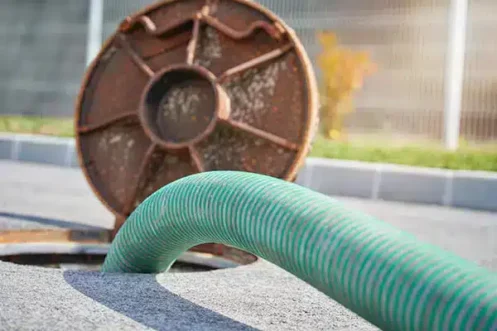
If your Columbus, OH home has a septic tank, you have to know how to find it. After all, this tank should be professionally cleaned every three to five years to prevent whole-house, wastewater backups. Knowing where your septic tank is will also help you identify common signs of developing problems. Read on to find out more about typical septic tank locations and how to look for yours.
Check City or County Records for Your Home’s Building Plans
You may be able to locate the septic tank on your property without putting your boots on and getting your hands dirty. After all, the company that installed this tank was required to file a permit application. This application included the dimensions of the tank, a diagram expressing its location relative to other property features, and other factors that could help you pinpoint its position. If you aren’t keen on the idea of trudging through your yard with a soil probe in hand, this is a great way to start your search. Also known as an “as-built,” this same diagram can also be found in the reports for pre-purchase inspections.
Look for High and Low Spots in Your Yard
One way to get a general idea of where your septic tank is located is by looking for high and low spots in your yard. These are dips and rises in the overall grading of your land that are concentrated within a single area. Immediately after installation, septic tanks are usually easy to spot given that they’re covered with fresh, dark soil rather than bright green grass. However, over time, these areas gradually blend in with their surroundings. Marking high and low spots that are grouped together will help you determine which area to target when using a prodding stick or soil probe.
Your Septic Tank Is Installed Along Your Home’s Main Sewer Line
The main sewer lines for homes that lack septic tanks travel underground to the municipal sewer system. Although your home has a septic tank, it still has a main sewer line. Moreover, your tank is definitely connected to it. You’ll find this line in your basement or in a basement crawlspace. It should be about four inches in diameter and exit through the exterior wall at the rear of the building. Most septic tanks are located between 10 and 25 feet away from this exit point. When you spot your main sewer line, get ready to use your soil probe.
How to Use a Soil Probe to Find Your Septic Tank
The depth of septic tanks varies significantly from property to property. Some septic tanks are covered by as much as four feet of earth. Despite being initially difficult to spot, others are covered by a scant, four-inch layer of soil or grass. Soil probes allow homeowners to gently push through the earth until they connect with hard fiberglass, flat concrete, or polyethylene lids or tank walls. You can purchase a soil probe at your local home and hardware store, or you can simply use a sturdy and sufficiently long stick. When using a soil probe of any kind, you should only apply as much pressure as necessary for moving through the soil. Applying too much pressure or ramming your probe forcefully into the earth could result in a broken tank lid or other forms of tank damage.
Start at the exterior wall that your main sewer line exits from. Then, walk in a straight line away from this exit point while probing the soil every one to two feet. You shouldn’t have to walk far at all before hitting your target.
You May Need a Hammer
Using a probe to push through up to four feet of soil is no easy feat. Fortunately, you can safely use a hammer to drive your soil probe down when you reach tough areas. However, when doing so, use short and easy hammer strikes to prevent rapid probe movement. You should also be mindful of the fact that areas of high-resistance could be a sign that you’ve actually encountered your tank.
Defining the Perimeter of Your Septic Tank and Locating Its Lids
If you’re lucky, “as-built” diagrams from city or county records will give you detailed information on your septic tank’s exact location and size. If you can’t find an “as-built” for your home’s septic tank, you may be able to use the sunken and raised areas of your yard to map out its perimeter on your own. Probing the soil by starting at the exit point of your home’s main sewer line will give you additional clues concerning the tank’s location. Keeping a notebook handy will help you piece all of your clues together so that you eventually know how many feet your septic tank is away from your home and how deeply it’s buried.
Knowing the age of your home’s septic tank can help as well. Older septic tanks or tanks that were designed and installed before 1974 have a single, two-foot lid right at their center. Newer tanks or tanks that were designed and installed after 1975 have two separate lids at their opposing sides. Many new tanks also have two separate compartments to accommodate greater amounts of wastewater and effluence. Modern, two-compartment tanks may even have as many as three lids.
Keep in mind that the maximum lifespan of even a well-maintained septic tank is 30 years. Thus, if you’re probing away in your yard and find a septic tank with a single, two-foot lid at its center, you should start planning to replace this unit right away.
A Metal Detector Could Come in Handy
Most septic tanks have quite a few metal elements. Thus, if all other efforts to find your septic tank fail, you may be able to use a metal detector. However, you shouldn’t grab the same detector that you use to find coins or lost jewelry in parks or on sandy beaches. Instead, you’ll need a magnetic locator. This is a special metal detector that can only detect steel and iron. A magnetic locator will pick up the iron rebar in a reinforced concrete tank or the iron in its lid handles. If you happen to have a steel septic tank, a magnetic locator will pick up the steel in its walls. You can use this tool to pinpoint your septic tank’s exact location, define its perimeter, and identify the location of all of its lids.
Trust the Professionals
Some people love solving mysteries. Searching for an “as-built” diagram and probing the soil in your yard might feel a bit like an adventure. However, in most cases, it’s far less exciting than searching for buried treasure. A hidden septic tank, especially one that’s covered in up to four feet of soil, can be an endless source of frustration. Fortunately, we’re always here to piece the clues together for you. We can find your septic tank in no time. We can also identify the exact size and model that you own, map out the position of its lids and show you its entire perimeter. With the information we collect, we can also help you determine the best septic tank pumping schedule for your property.
We offer superior plumbing, drain cleaning, and HVAC services to residents of Columbus, Ohio and the surrounding areas. We also service septic tanks. If you need help locating the septic tank on your property or if your septic tank needs cleaned, contact Apex Plumbing, Heating, and Air Pros today!





